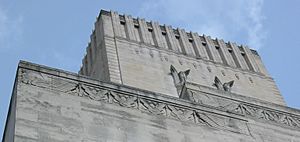Ventilation facts for kids
A ventilation system helps control the air moving inside buildings. Its main job is to bring in fresh air, usually from outside. At the same time, it pushes out old, stale air. These systems often use fans, pumps, and special tunnels to move the air around.

Contents
How Air Moves: Ventilation Basics
Ventilation systems make sure that fresh air is always coming into a space. This helps to remove air that might be full of smells, dust, or even tiny germs. It's like giving a room a constant breath of fresh air!
Natural Ventilation
The simplest way to ventilate a space is through "natural ventilation." This means air moves on its own. It uses things like open windows, doors, or special vents that connect to the outside. Imagine opening a window to let a cool breeze in; that's natural ventilation at work.
Mechanical Ventilation
"Mechanical ventilation" uses machines to move air. These systems are more common in large buildings or industrial places. They use fans and other equipment to push and pull air. Mechanical systems can also control other things. They can adjust the air's temperature, how much moisture is in it, and even the oxygen levels.
Why We Need Fresh Air
Having fresh air is super important for many reasons.
Keeping Things Clean and Healthy
Fresh air helps stop mold and bacteria from growing. These can make people sick or damage buildings. It also helps prevent the spread of diseases. Plus, good ventilation helps get rid of dust, making our living spaces cleaner.
More Than Just Buildings
While we often think of ventilation in houses, it's used in many places.
- Working with Heating and Cooling: Ventilation often works with heating and air conditioning systems. It helps spread warm or cool air evenly.
- Vehicles: Cars, buses, and trains also have ventilation systems. These keep the air inside fresh and comfortable for passengers.
A Look Back: History of Ventilation
People have been trying to control air flow for a very long time.
Ancient Windcatchers
In ancient Persia, people built special structures called "windcatchers." These tall towers were designed to catch the wind and direct it into buildings. They created a natural cooling and ventilation system. Windcatchers became very popular. You can still see them in use across the Middle East today. They show how clever ancient engineers were!
See also
 In Spanish: Ventilación para niños
In Spanish: Ventilación para niños



